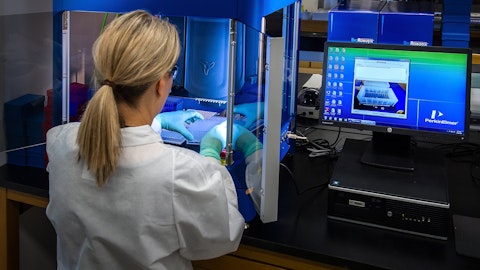Joseph Payne: Yes. With respect to the other vaccine or vaccines getting approved in Japan, we’re very happy to see that Japan is following their domestic strategic plan. We touched on this earlier in the call a little bit. We view this very positive because we feel like we’re part of this domestic plan with Meiji and CSL but our — what sets this vaccine technology apart from all other conventional mRNA vaccines that have been approved or soon to be approved is our dose level. So our dose level is significantly lower, our CR response rates that we’ve observed seemed to be differentiating. Clearly, people have to be taking this dose level into consideration when it comes to safety and reactogenicity as potentially differentiating.
And then finally, the data we showed today, the durability data is very promising. So — and can set this technology apart. So as we work with Japan in their strategy, we definitely see a way to fit in line with their objectives to address some of the key issues in protecting their people with a vaccine strategy.
Yanan Zhu: Got it. Thanks for the color. And you touched on durability, congrats on the data. I was wondering, can you talk about the underlying biological basis for this durability and your confidence that we could see this observation replicated in the longer follow-up for the Japan study?
Joseph Payne: Yes, it’s great question. Self-amplifying mRNA is providing very encouraging durability data and your question is why. And it’s because the mechanism of how this — the self-amplifying mRNA molecules make the antigen. Conventional mRNA make the antigen for a period of time and then degrades, right? But self-amplifying mRNA, this next-generation mRNA technology extends the duration of making that antigen. So the body sees the antigen for a longer period of time. That means it is allowed to increase the antibody titer levels and that’s what we’ve seen in the Phase 3 comparison study and we’ve all — because the body sees the antigen for a longer period of time, it allows a broader spectrum of antibodies to be made.
And when you combine those two features of increased antibody titers with a broader spectrum of antibodies being created by the body, this translates into a longer-lasting vaccine and that would provide an explanation as to explaining what, and why we’re seeing what we’re seeing.
Yanan Zhu: Got it. So we might — we should be able to see something similar with the Japan study, correct?
Joseph Payne: Yes. Correct, correct. That’s what you would expect. And remember, previously we’ve seen in our Phase 1 and Phase 2 studies that the antibodies titer levels tend to increase beyond one month or beyond four weeks. So will we see that as well in Phase 3 is yet to be understood. But, yes, our expectations are high and very optimistic.
Yanan Zhu: Got it. Thanks for the color. And lastly on the OTC deficiency program. I was wondering in the news release, you mentioned you may announce data from a subset of the patients. I was wondering, could we expect one or both cohorts of the patients data being reported out and what type of changes clinically or in terms of biomarkers can be expected with a roughly a three-month duration? And lastly, would you be able to comment on any next steps that we can expect once you have reported the data? Thanks.
Joseph Payne: Well, I appreciate the question and wanting to understand additional detail on different dose levels in the OTC clinical trial. But the only guidance we’re providing today is some biological proof of concept or some biological data that will provide in a subset of patients. So I can’t provide any more detail than that. With respect to any biomarkers that we’re tracking, we will be tracking them for an extended period of time. And that includes ammonia and urea genesis and other amino acids and it can be such as glutamate, for example, can be measured but several amino acids are impacted by the urea cycle and OTC itself can be measured. The Ornithine Transcarbamylase Enzyme that’s built or expressed in these liver cells, these lever cells just as you are aware can be swept off into the circulation and measured in the plasma. And so we can track OTC levels as well and over an extended period of time.




